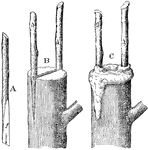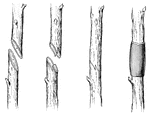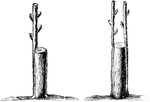Clipart tagged: ‘grafting’

Bud and Graft
This illustration shows a tree that has been both branch-budded and grafted. Buds inserted in August.…

Cleft Grafting
This illustration shows a method of cleft grafting. Part A shows the scion, B, the scions inserted in…

Cleft-Grafting
"Cleft-grafting is another method in common use. The stock a is cleft down from the horizontal cut d,…

Crown-Grafting
"Crown-grafting is preferable to cleft-grafting, inasmuch as it leaves no open spaces in the wood. The…

Root-Grafting of Dahlia
Grafting is a method of asexual plant propagation widely used in agriculture and horticulture where…

Grafting
(a) the two branches to be joined; (b) a tounge cut in each; (c) how fitted together; (d) method of…

Grafting by Approach
Grafting is placing two cut surfaces of one or different plants under conditions which cause them to…

Cleft Grafting
(a) cut several scions, each having a few buds, making the ends in a wedge shape; (b) insert scions…

Cleft Grafting
Grafting is placing two cut surfaces of one or different plants under conditions which cause them to…

Cleft Grafting
Grafting is placing two cut surfaces of one or different plants under conditions which cause them to…

Crown or Rind Grafting
Grafting is placing two cut surfaces of one or different plants under conditions which cause them to…

Double Grafting
Grafting is placing two cut surfaces of one or different plants under conditions which cause them to…

Root Grafting
Grafting is placing two cut surfaces of one or different plants under conditions which cause them to…
Root Grafting
A cion (smooth, one year old lenth of twig cut into a sex inch length) and root pictured, about to be…

Saddle Grafting
Grafting is placing two cut surfaces of one or different plants under conditions which cause them to…

Side Grafting
Grafting is placing two cut surfaces of one or different plants under conditions which cause them to…
Wedge Grafting
Grafting is placing two cut surfaces of one or different plants under conditions which cause them to…

Whip or Tongue Grafting
Grafting is placing two cut surfaces of one or different plants under conditions which cause them to…
Graft of Mammillaria on Cereus Stock
Delicate species of mammillaria thrive when grafted on some cereus stock.

Mulberry Grafting
Illustrated is a method of mulberry grafting: (a) the cion, (b) matrix to receive the cion, (c) the…

Root-Grafting
"Fahlias and paeonies may be grafted by inserting young shoots into the neck of one of the fleshy roots…

Root-Grafting
"In the case of large woody plants thus worked the grafted roots, after the operation is completed,…

Shield-Budding
"The simplest and most generally practised form of budding is that called Shield budding or T-budding.…

Tongue Grafting
To graft two plants together using the tongue or whip grafting approach, you must first make a sloping…

Whip-Grafting
"Whip-grafting or tongue-grafting is the most usual mode of performing the operation. The stock is headed…

Root-Grafting of Woody Plant
Grafting is a method of asexual plant propagation widely used in agriculture and horticulture where…



